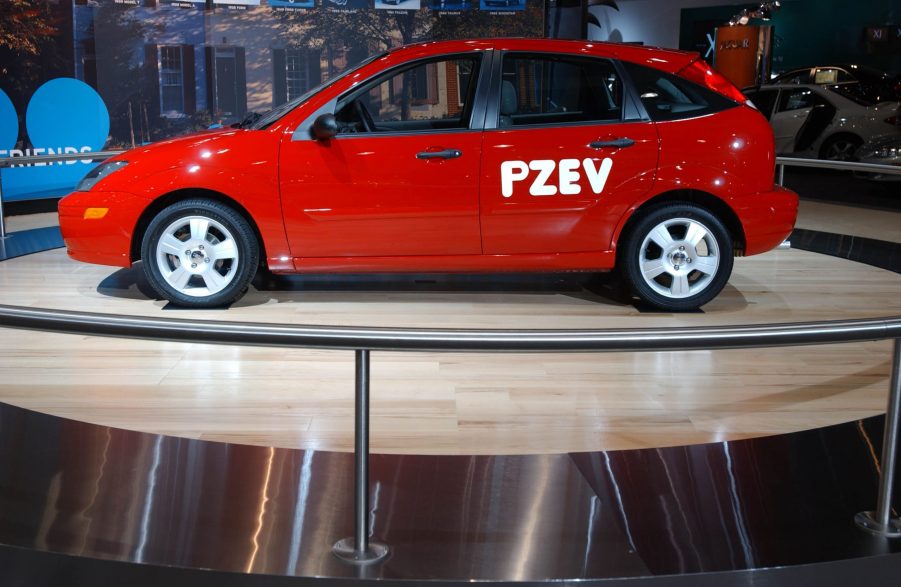
What Does PZEV Stand For?
If you’ve ever noticed vehicles displaying the acronym “PZEV” and wondered what it means, you’re not alone. These eco-friendly cars don’t get a lot of media coverage, but their technology is slowly taking over the auto industry.
Short for Partial Zero-Emissions Vehicle, PZEV is a classification that you will often see on hybrid cars, although it can be found on any fuel-powered vehicle. Here’s everything you should know about these cars, according to Autotrader.
The basics of PZEVs
Unlike Zero-Emissions Vehicles (ZEV), which are either fuel cell electric or battery electric, PZEVs are typically conventional cars that utilize gasoline-powered internal combustion engines.
PZEVs differ from standard gas-powered vehicles in that they have significantly lower emissions, as you may find in many hybrid options. However, not all hybrids meet the strict specifications required to be a PZEV — they must be classified as Super Ultra-Low Emissions Vehicles (SULEV) by the EPA to qualify.
Additionally, these vehicles feature a few unique upgrades within the fuel systems. In most standard vehicles, fuel will continue to evaporate even once the car has been turned off. This evaporation leads to increased emissions and pollution. In PZEV systems, automakers have added components to reduce or eliminate these emissions.
These emissions systems also have incredibly long warranties, typically of approximately 150,000 miles or 15 years. While this can sometimes increase the cost of PZEVs, it helps ensure that the vehicle continues functioning properly and meeting its strict standards.
How PZEV systems work

According to Car and Driver, there are four components that set PZEVs apart from standard vehicles. The first is an anti-permeation fuel system liner: multiple layers of low-permeability polymers that line the caps, hoses, fuel tanks, gaskets, and seals within the fuel system. This is the main component that prevents gas emissions from occurring when the vehicle is switched off.
Next, carbon canister scrubbers help prevent gas from escaping as it evaporates during temperature fluctuations. While all cars will typically feature a carbon canister for this purpose, PZEVs add a scrubber to reduce these emissions even further. These systems also employ carbon air intake traps, which serve a similar role in preventing gas vapors from escaping the vehicle.
Finally, close-coupled catalytic converters sit within the exhaust system to help convert the escaping gas into less harmful gases. While all fuel-powered vehicles utilize catalytic converters, PZEVs use three and mount them closer to the engine, creating a system that more effectively captures smog-inducing pollutants such as nitric oxide.
Which automakers offer these vehicles?
Related: How to Make Your Gas-Driven Car More Eco-Friendly
Initially, PZEV technology was created to follow California’s strict emissions laws. Although they don’t get a lot of press, plenty of popular automakers have adopted this technology and offered PZEV options throughout the years. Among them are Hyundai, Volkswagen, and Ford. According to Car and Driver, one of the earliest automakers to begin producing PZEVs was Subaru.
If you’re looking for a gas-powered vehicle, a PZEV is one of the cleanest options available. It offers a number of benefits — perhaps most notably, reducing smog but do not require the driver to seek out any type of alternative fuel.
Car and Driver report that PZEVs decrease the emissions that cause smog and acid rain by at least 90 percent when compared to standard vehicles. However, it is important to note that PZEVs do not actually reduce carbon dioxide emissions. Rather than being a permanent eco-friendly solution, automakers consider PZEVs to be a beneficial but temporary solution as the industry continues to move toward electric and alternative fuel vehicles.
Although the PZEV classification itself disappeared in 2018, the EPA’s most recent regulations have required most automakers to begin incorporating this technology into all vehicles. In fact, if you purchased a new car sometime in the past two years, you might just have been driving a PZEV without even realizing it.


